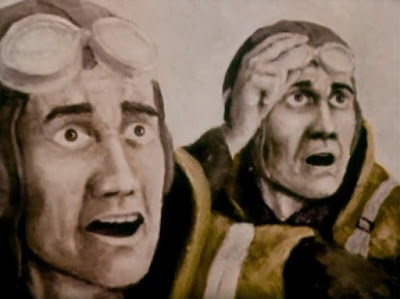Since its heyday in the crypto-addled 1970s, many myths about the dreaded Bermuda Triangle have long since been debunked, with plenty of plausible and practical explanations for the large number of ships and aircraft that have entered this geometric anomaly only to never be heard from again. Even way back then some researchers were working hard to separate the facts from the fabrications. And one of the loudest was a man named Richard Winer.
Winer was a writer, sailor, and underwater photographer, who had served as a cinematographer on Michael Harris' documentary, Deadly Fathoms (1973), which focused on the ecological impact of all the nuclear bomb testing near Bikini Atoll and the surrounding Pacific. Around this same time, Winer was also writing several sobering magazine articles about the Bermuda Triangle.
But soon tired of all the sensationalist spins his editors kept putting on his work -- “Bermuda Triangle: UFO Hot-Zone”, “The Deadly Bermuda Triangle: Flying Saucer ‘Space Warp’ Domain” -- Winer managed to get his own version published in the expose The Devil's Triangle (1974), where he focused more on documenting the Triangle's more notorious cases, weeding out all the embellishing and sticking to the facts, and left any non-scientific speculation as to the possible causes completely out of the mix.
In fact, in the last chapter of the book, Winer addresses these preternatural angles and seems to take great pleasure at taking pithy potshots at his contemporaries -- John Wallace Spencer, Charles Berlitz, and Edgar Cayce -- for their *ahem* ‘outlandish theorizing on magnetic space-warps, UFOs, and rogue Atlanteans.’
The Buffalo News (June 24, 1971).
Now, before the book was published, Winer and news producer Larry Kelsey of WNEW, New York, teamed up and started putting together a documentary on the Bermuda Triangle, which he also called The Devil's Triangle (1971) that ABC would broadcast nationally.
Two years in the making, alas, all my digging could not find an exact broadcast date but most sources say it originally aired regionally in the northeast in June, 1971, and later broadcast again to a wider audience in November, 1971. Then, in 1974, perhaps to cash in on the release of his book, the feature was released theatrically, where the 54-minute doc was often paired with other paranormal retreads, like the anthology film, Encounter with the Unknown (1972). I remember it playing in my area back in '75 with The Outer Space Connection (1975), at least the newspaper and radio ads for it, but I didn't get to see it until much, much later.
The Sacramento Bee (November 8, 1974).
The documentary itself covers most of the same ground, case wise, as Berlitz's The Bermuda Triangle (1979) did five years later -- Flight 19, the strange case of the Ellen Austin, and the U.S.S. Cyclops among others. But like with Winer's book, the film digs a little deeper into the history of each case to give the audience a wider view of these tragedies, sticking with speculation on bad weather, faulty equipment, and inexperienced sailors and pilots as the most probable explanations.
The production also scored a major coup with the inclusion of Alan Kosnar, a retired Marine tail-gunner, who begged off sick and thus was excused from participating in Flight 19, who gives a firsthand account of the day his comrades disappeared back in 1945. The film is also littered with several other nautical and aviation experts, but the film's biggest asset was who Winer and Kelsey managed to get to serve as our narrator.
Alan Kosnar
As the old saying goes, there are some people you would gladly listen to if they just read you the phonebook. Here, we get the great Vincent Price adding a slightly sinister twinge to all of these salty sea mysteries, and he is simply delightful.
As for the footage he fills us in on, in lieu of any actual recreations of the events, we are treated to a lot of stock footage, vintage photos, some rather obvious scale models, and some fairly effective montage sequences where the camera crash-cuts between several Edvard Munchian-style paintings of what might have happened to all these doomed sailors and airmen.
All of this is then fleshed out with a soundtrack provided by King Crimson. Well, mostly just one song, "The Devil's Triangle," from their In the Wake of Poseidon album, which is used over and over and over again.
And that about sums up the film: repetitive, as each tale comes off a little too lather, rinse and repeat. But if you're a crypto-nut like me, or a huge Vincent Price fan, you'll want to track this down and give it a spin. Beyond that, there's no reason why The Devil's Triangle couldn't just stay lost forever.
Originally posted on October 9, 2015, at Micro-Brewed Reviews.
The Devil's Triangle (1974) Libert Films :: UFO Productions :: WNEW New York :: American Broadcasting Company (ABC) / P: Richard Winer / AP: Larry Kelsey / D: Richard Winer / W: Worley Thorne, Richard Winer (novel) / E: Steve Cuiffo / M: King Crimson / S: Vincent Price

%201974.jpg)











%201974.jpg)
No comments:
Post a Comment